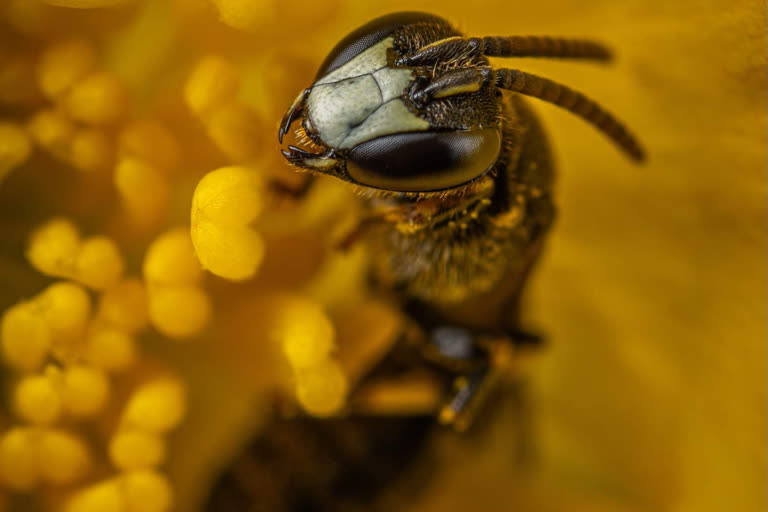London: Almost 35 percent of all invertebrate pollinators, particularly bees and butterflies, are facing extinction, according to the United Nations.
On World Bee Day, marked on May 20, the UN is underlining the importance of bees and pollinators and the threats they face from pollution, pesticides and habitat loss.
Under lockdown, bees are thriving, as roadside verges, parks and open spaces are left to grow - increasing sources of nectar.
With a clear view of London's Shard skyscraper, eight hives buzz with activity.
They're nestled on top of a four-storey townhouse, at tree top-level, in Bermondsey, south London.
Read | Cyclone Amphan: Bangladesh shifts two million people; forces on alert
The hives belong to Dale Gibson, co-founder of Bermondsey Street Bees, which supplies honey to hotels, restaurants, gift shops and beer makers.
"When the bees make enough honey, we can take the harvest from them, making sure that we leave enough for them to get through the winter and spring. So, this is just the beginning of the urban season, starting to make honey," says Gibson.
In total, Bermondsey Street Bees looks after 84 hives in and around the British capital. This is a commercial hive, but according to the British Beekeepers Association (BBKA), membership has risen from 11,000 in 2008, to approximately 25,000 hobbyist beekeepers today.
"There are 740 apiary sites within a ten-kilometer radius of here right in the middle of Bermondsey Street. And that's more than double the national average," explains Gibson.
Read | Virus could push millions of Africans into poverty: UN chief
"London isn't making any more green space. We have to make better use of the green space. We have to have more forage provision for all pollinators because the honeybee is just one of 250 native bee species in the UK."
With urban beekeepers swarming the city, Gibson says it's important that apiarists ensure their hives are sustainable, by planting enough nectar sources for the bees. The number of bees is declining worldwide. But under lockdown, Bermondsey Street Bees says these vital insects have been benefiting.
Many countrysides verge and green patches across the city have not been cut back due to reduced staffing and have instead become flowering holes for insects, bees and other pollinators.
A few minutes' walks from the rooftop hives is a garden where Bermondsey Street Bees co-founder Sarah Wyndham Lewis grows bee-friendly flowering plants, trees and herbs.
"We feel acute that living in this city where things are a delicate balance in nature because they're under pressure from so many directions, it falls to us to plant for our bees to offset their presence in the environment," she says.
Plantlife is a British conservation charity that aims to help and save threatened wildflowers, plants and fungi.
Dr. Trevor Dines, a botanical specialist for the organisation, points out how easy it is for people with gardens to help bee populations thrive. "There's a direct link between bees and loss of their wildflower habitat. So, we know that 97 per cent of wildflower meadows have been destroyed in Britain. And that's just an enormous loss of nectar basically and colour from the countryside. So, places like our lawns and our road verges become much more important for those," says Dines.
According to Plantlife research, the highest production of flowers and nectar is on lawns cut every four weeks.
"It's about cutting down on the cutting down and letting those flowers flower and do their job and giving them time to do that," says Dines.
About 90 percent of the world's wild flowering plant species depend on pollination, along with more than 75 percent of the world's food crops and 35 percent of global agricultural land, according to the UN's Food and Agriculture Organization (FAO).
The FAO says between USD 235 and USD 577 billion USD worth of annual global food production relies directly on pollinators. But almost 35 percent of all invertebrate pollinators, particularly bees and butterflies are facing extinction. Crops dependent on pollinators include coffee, chocolate, sunflower and sesame oils and tea plants.
According to the FAO wild pollinators are being threatened by a variety of factors, from habitat destruction and intensive agriculture to pesticides, disease, climate change and poor beekeeping practices.
In the US, the California almond crop requires more than 1.5 million honeybee colonies, according to the USDA National Agricultural Statistics Service. To meet demand, bees are transported to areas where pollination is needed.
Bees for Development is an international charity focused on promoting sustainable beekeeping as a means of alleviating poverty and promoting biodiversity."Scientifically, we are very worried about this, moving bees around the world. And if the virus pandemic causes us to rethink that, that's a very good thing actually," says the charity's founder and director, Dr. Nicola Bradbear.
"There's huge world trade in moving bees from Australia to North America, moving bees from Egypt to the Middle East all of this by air.
"It's a huge carbon cost and for honeybee populations, it's kind of a bad thing because that's how we have managed to spread diseases and ironically viruses in bees."
United Nations World Bee Day is marked annually on 20 May.
(AP)



